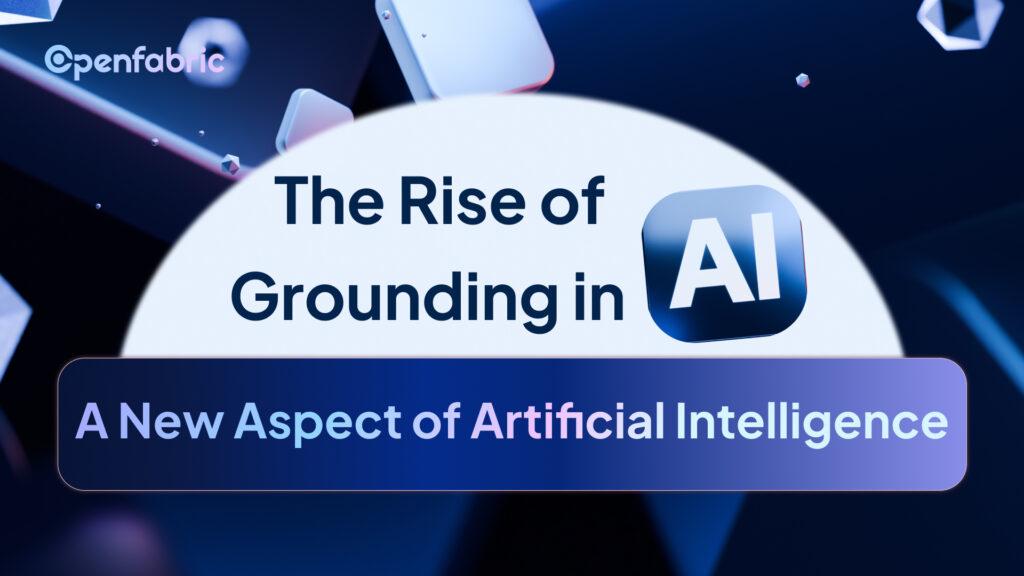
October 3, 2025 5 minutes read
The Rise of Grounding in AI: A New Aspect of Artificial Intelligence

There has always been one challenge with the results from generative AI search: getting accurate results from search queries. However, since the beginning, engineers have been constantly working on improving the accuracy of the search results that AI generates, and all these efforts have led to what we have today as grounding in AI.
The problem with inaccuracies in query results was primarily because many AI systems were not connected to real-world facts, or the facts they were connected to were outdated and irrelevant. In fact, most of these AI systems predicted results based on data patterns and not necessarily the facts. This is where grounding comes in.
Grounding ensures that AI systems don’t just generate results based solely on patterns, but generate results that are factual and accurate. In our world, where sharing of information is easier and faster, the wrong information can cause irreversible and very costly damage. Hence, there is a need for AI systems that are accurate.
In this article, we will discover how grounding in AI works and why it is very important in making AI systems more reliable.
Let’s get started!
What is grounding in AI?
Grounding in AI is the process of connecting an AI model’s output to verifiable, real-world data in a bid to improve the accuracy of its search results, which in turn increases its reliability and relevance to the end-users. It is kind of giving LLM a fact-checker
In more technical terms, it anchors the responses of a large language model (LLM) in specific, up-to-date information that helps to prevent the generation of incorrect responses through a fact-checking mechanism. These incorrect responses are also called “hallucinated” content.
How does grounding in AI work?
Grounding is a continuous process of refinement to ensure that the LLM leverages real-world data in the generation of its results effectively. The steps involved in grounding include:
Natural Language Processing (NLP)
NLP is an important aspect of grounding that must be achieved before any of the other aspects can work. It involves contextual understanding of the user’s queries. The AI first interprets the user’s input to understand the context of the input before generating a response.
Context retrieval through Retrieval Augmented Generation (RAG) and data integration
RAG is a technology that is widely implemented for grounding LLMs. This method requires the relevant context and information. Therefore, a retriever is placed between the question and the LLM, which generates the output in plain text and passes only the relevant information to the LLM. However, RAG achieves better accuracy when the AI model already has existing knowledge and relevant data in their memory through hyperparameter training. It combines this existing data with real-time data to provide more accurate and up-to-date responses.
Response generation with grounding
The response that the AI generates is both factual and fluent. The language is natural, and the information is backed by an external source that may be citations or references, which even allows users to verify the information themselves.
What are the benefits of grounding in AI?
Grounding in AI serves various functions, which include:
- Reduces AI hallucinations: AI hallucinations are responses that are either inaccurate or contextually irrelevant. Grounding reduces hallucinations by using real-world data in its responses and linking these data with pre-existing data obtained by the AI model through hyperparameter training.
- Improves trust and accuracy: by ensuring that AI models generate responses that align with reliable and authoritative sources, it enhances the trust between users and the AI model.
- Context awareness enhancement: previously, AI models used NLP for context awareness. However, this technology has its limitations, but it serves as the basis of contextual awareness by AI models. Grounding takes what NLP does and enhances it. Therefore, AI now has the ability to be more contextually aware, which in turn improves the quality of its responses.
- Security and compliance: grounding models with existing legislation and regulations integrates security guidance in the use of AI. This way, there can be certain regulations or restrictions in the use of AI that would protect certain individuals, for example, children. It can also help in controlling the type of input or output to ensure that it does not cause a breach of security or violate regulatory policies.
- Utilization of recent data: earlier, we highlighted the danger of incorrect or irrelevant data in our world, where information sharing occurs in a matter of seconds with just one click. Grounding mitigates the generation of incorrect data by utilizing the most recent information for its responses.
What are the challenges of grounding in AI?
Although grounding is set to change the way we interact with artificial intelligence, as a relatively new technology, it has its own challenges.
Many of these challenges are related to the intricacies and complexities of the human language. We are, after all, the most intellectual species on earth; therefore, creating a computer to understand us will not be a walk in the park.
Despite all of these, the most relevant challenge in grounding is the symbol grounding problem. This explains how AI systems interpret symbols and map them to actual, real-life concepts. As such, AI models may find it difficult to relate the deeper meaning of their inputs to the real world.
In addition, the complexity of the human language poses a challenge to generated outputs. Words or sentences with double meanings may be wrongly interpreted.
What are the real-world applications of grounding in AI?
Already, grounding is transforming the way industries operate. Its real-world applications can be found in industries such as:
- Healthcare: for providing accurate diagnosis, drug recommendations, and updated guidelines from verified clinical data.
- Education: in explaining topics using resources that are aligned with the student’s curriculum.
- Finance and cryptocurrency: using AI systems to monitor stock and economic data live and on the go, ensuring that finance experts are always in the loop.
- Customer service: to provide accurate responses to queries from customers, instead of vague answers.
Conclusion
Artificial Intelligence is not just a one-bus-stop show. It is a moving train that keeps changing and evolving to ensure that we get the results. The rise of grounding in AI represents this change. By linking LLMs to real-world data and references, it ensures that AI models provide the most accurate responses for users.
As AI adoption increases, many more industries will begin to integrate grounding techniques into their systems to ensure a safe, transparent, and reliable AI system.
At the end of the day, it is not only about making AI systems smarter. It is also about making them safe and responsible enough to partner with humans for the best results.
For more information, visit our WEBSITE today!!!

